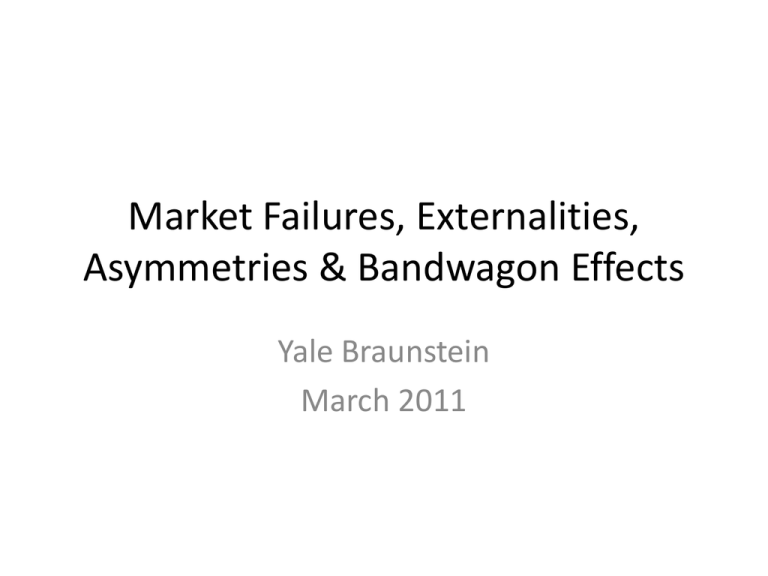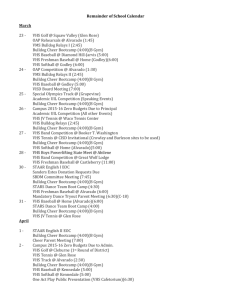Market Failures, Externalities, Asymmetries & Bandwagon
advertisement

Market Failures, Externalities, Asymmetries & Bandwagon Effects Yale Braunstein March 2011 Quick intro to “Consumers Surplus” • • • • Actually, the sum of CS & PS Consumers gain from price decreases PS = Profit Monopoly works by restricting output & raining price, therefore results in “deadweight welfare loss” – Graphical measure of DWL Market Failure • Need a formal definition – More than just “market doesn’t do what we want it to do” • Role of monopolization • Role of information asymmetries • (Price discrimination can actually be beneficial) – But this is not always the case Externalities • Can be positive or negative • Can occur from production or consumption • 2x2 diagram of examples Positive Negative Production Useful by-products Effluents (e.g. bees & honey) Consumption CO2 cycle Congestion “Solutions” to externalities • • • • Taxes Subsidies Regulation Better definition of property rights – “Unitization” as an example – More when we get to Coases’ Theorem Bandwagon effects - History • Harvey Leibenstein, 1950 • H. Leibenstein, “Bandwagon, Snob, and Veblen Effects in the Theory of Consumers’ Demand,” The Quarterly Journal of Economics (May 1950), reprinted in W. Breit and H.M. Hochman, Readings in Microeconomics, Second Edition (New York: Holt, Rinehart and Winston, Inc., 1971), pp. 115116 • “the extent to which the demand for a commodity is increased due to the fact that others are also consuming the same commodity. It represents the desire of people to purchase a commodity in order to get into ‘the swim of things’; in order to conform with the people they wish to be associated with; in order to be fashionable or stylish; or, in order to appear to be ‘one of the boys.’” History (2) • Jeffrey H. Rohlfs, 1974 • J. Rohlfs, “A Theory of Interdependent Demand for a Communications Service,” Bell Journal of Economics and Management Science (Spring 1974), p. 16. • “The utility that a subscriber derives from a communications service increases as others join the system. This is a classic case of external economies in consumption and has fundamental importance for the economic analysis of the communications industry.” Network Externalities with an example from the 1980s – The Fax • Bandwagon effects in high tech industries often have a basis that goes beyond what is in the consumer’s head. In particular: 1) Network externalities: The benefit from being able to communicate with additional individuals who have also become users of the product or service (these apply to products and services that use telecommunications networks.) 2) (Example: the fax machine) External demand-side scale economics: Benefits that accrue to consumers as the user set expands. They are external to a single user, because the benefits to him or her derive from actions of others. Metcalfe’s Law • Value of network to users increases exponentially with the number of nodes/users • (Don’t believe everything you read in Wikipedia. Not necessarily a “square” law, and it didn’t come from George Gilder.) • (Role of Xerox PARC and 3Com in development of Ethernet.) • More on compatibility standards after the break. Back to Bandwagon Effects – Beta vs. VHS • Bandwagon effect: A benefit that a person enjoys as others do the same thing that he or she does. In particular, a consumer may enjoy bandwagon effects as others consume the same product or service that he or she does. • Bandwagon effects in high tech industries often have a basis that goes beyond what is in the consumer’s head. • Complementary bandwagon effects: These apply to products whose value derives, at least in part, from use of competitively supplied complementary products Beta vs. VHS • “In my opinion, the Sony-developed Beta format is superior to VHS in several ways, including better cassette design, superior tape handling, and overall better video engineering.”-Video expert, Columnist of the journal “Video” • But “technical superiority” is not the issue. Beta vs. VHS By 1980, only a year or so into the battle, VHS had captured nearly 70% of the market. Beta could initially claim the rest, but V2000 arrived to complicate the picture. The first generation of V2000 machines were poorly specified and expensive, so despite its undisputed technical merits the format failed to capture the public imagination. Theives raiding an electronics warehouse in 1983 cleared out all the VHS and Beta machines, but didn't take a single V2000 deck...











